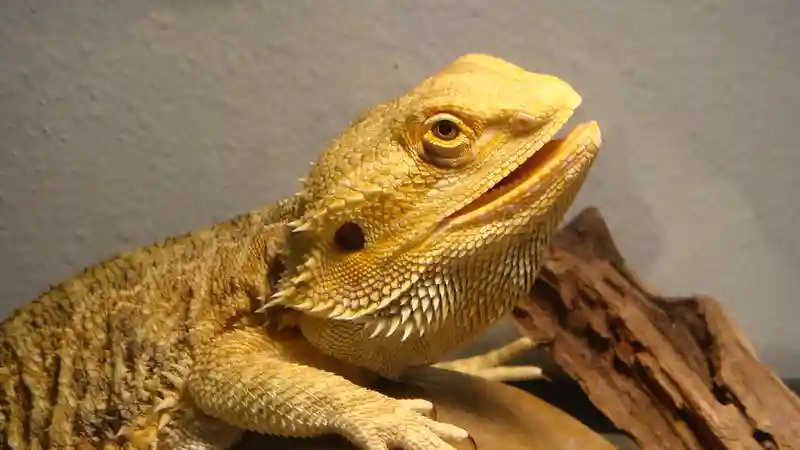To bearded dragon-proof a room, follow these steps:
- Choose a specific room where you can control the surroundings more easily and avoid stressful situations for your pet.
- Block access to potentially hazardous spaces, such as the kitchen and bathroom.
- Remove any small objects or toys from the floor that your bearded dragon might try to eat.
- Block access to narrow spaces that are difficult for you to reach in case your pet gets stuck.
- If you have other pets, especially cats or dogs, keep them away from the bearded dragon while it roams.
- Close off areas that you have not dragon-proofed, ensuring your pet cannot get injured.
- Consider using a bearded dragon harness if you’re new to letting your pet roam outside its enclosure.
- Always supervise your bearded dragon while it is roaming and never leave it unattended.
Identify Potential Hazards
Before allowing your bearded dragon free access to a room, it is essential to identify potential hazards.
Bearded dragons are curious animals and like to explore their surroundings, which can lead to them coming into contact with objects and substances that could harm them. Some common hazards to be aware of include:
- Electrical cords and outlets
- Toxic plants
- Sharp objects
- Small objects that could be swallowed
- Open windows and doors
- Other pets
11 Tips & Precautions For Letting Your Bearded Dragon Out Of Its Enclosure
To ensure your bearded dragon’s safety, follow these 11 essential tips and precautions:
Secure the Space
Before letting your bearded dragon out, make sure you close all doors and windows to prevent escape. Also, block any gaps under furniture or appliances where your pet might hide or get stuck.
Remove Harmful Objects
Remove any objects that could potentially harm your bearded dragon, such as sharp objects, toxic plants, or chemicals. It’s also a good idea to keep electrical cords out of reach, as your pet may chew on them.
Avoid Small Spaces
Bearded dragons can squeeze into tight spaces, which could be dangerous. Seal off any small gaps or holes, and be cautious about allowing your bearded dragon near furniture or appliances with small openings.
Keep an Eye on Temperature and Humidity
Ensure that the room’s temperature and humidity levels are suitable for your bearded dragon. They prefer temperatures between 75°F and 85°F (24°C and 29°C) with a basking area of around 95°F to 105°F (35°C to 40°C).
Watch for Signs of Stress
Pay attention to your bearded dragon’s behavior for signs of stress or discomfort, such as rapid breathing, darkening of colors, or hiding. If you notice any signs of stress, return your bearded dragon to their enclosure.
Supervise at All Times
Always keep an eye on your bearded dragon while they’re out of their enclosure to ensure their safety and prevent any accidents.
Secure Electrical Cords and Outlets
Bearded dragons are known to chew on objects, including electrical cords, which can be dangerous. To prevent your pet from coming into contact with electrical cords and outlets, it is crucial to secure them. You can do this by using cord covers or running cords behind furniture. It is also essential to cover outlets with outlet covers to prevent your bearded dragon from sticking its tongue or nose inside.
Remove Toxic Plants
Some houseplants can be toxic to bearded dragons, so it is important to clear any plants that could be harmful. Some common plants that are toxic to bearded dragons include:
- Aloe Vera
- Pothos
- Ivy
- Philodendron
- Snake Plant
If you are unsure if a plant is toxic, it is best to err on the side of caution and remove it from the room.
Eliminate Sharp Objects
Sharp objects, such as knives or broken glass, can be dangerous to not only your bearded dragon but also to anyone else in the room. To be safe, remove all sharp objects from the room or store them in a secure location.
Remove Small Objects
Bearded dragons are known to explore their surroundings with their mouths, which means that they can easily swallow small objects. To prevent your pet from accidentally swallowing something that could cause harm, remove all small objects from the room.
Keep Other Pets Separate
Other pets can pose a danger to your bearded dragon or cause unnecessary stress. Be sure to provide separate living areas for your pets to ensure their safety and well-being.
FAQs
How often should I let my bearded dragon out of its enclosure?
There’s no set rule for how often to let your bearded dragon out, but providing them with supervised exploration time daily or a few times a week can be beneficial for their mental and physical health.
How long can a bearded dragon be out of its enclosure?
A bearded dragon can safely be out of its enclosure for around 15-30 minutes at a time, depending on the temperature and the individual’s comfort level.
Do bearded dragons need a harness when taken outdoors?
Using a harness is recommended when taking your bearded dragon outdoors. It ensures their safety and prevents them from running off or encountering potential dangers.
Can bearded dragons recognize their owners?
While bearded dragons may not have the same level of recognition as mammals, they can become familiar with their owners through routine handling, feeding, and interaction.
What should I do if my bearded dragon appears stressed while exploring?
If your bearded dragon shows signs of stress or discomfort while exploring, calmly return them to their enclosure and give them time to settle down. Observe their behavior and try again another day, making any necessary adjustments to their environment.


Leave a Reply